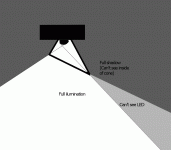Hello,
I am quite sensitive to light, and so I tend to prefer lighting in which the direct filament is blocked from my line of sight (i.e. I can't see it directly even in my peripheral vision).
One thing that looks promising that I've become aware of only recently is so-called "edge-lit" or "side-lit" LEDs. In these LED assemblies, the diodes are positioned perpendicular to the path through which the light is emitted. There are some materials that help direct the light out the right way--think of a periscope, or an illuminated Exit sign.
I will link to some examples below. Please note I don't endorse any of these lamps. My main concern is identifying <i>when</i> an item uses an edge-lit LED. Do you think they will always mention so when they are? They all seem to have a circular or square-like diffusion plate, as oppose to the more narrow ones I am used to. But often the manufacturers don't include a figure showing the parts of the light assembly separated.
Incidentally, I find it kind of annoying that a lot of LED lamps mention that they have some "eye care" technology, when really all that means is that they've taken steps to address some of the previous shortcomings of LEDs. I love LEDs, especially their prospects to create very light assemblies for use in industrial design and survival, but it kind of reminds me of when a polyester garment says it has "odor-fighting" properties. After buying a couple of these, I've come to realize that they just want to allay your concern that said garments will stink after one wear (and they invariably do).
Anyway, LED lights are much better than polyester at their intended purpose, but I just wanted to know why these are only making their way into lamp technology now. Is it just advances in optical materials? I know that cell phones are starting to come with "periscope" lenses, so that the chamber the light flows down is parallel to the phone itself, which will allow for greater focal lengths (sorry if I'm misusing some terminology).
Thanks.
Some examples for reference (these are non-affiliate links):
1) Lume Cube Edge Desk Lamp
This one looks like the fanciest, but it apparently hasn't been shipped yet, and is missing dimensions and lumen output information.
2) Eyocean Desk Lamp
3) Niulight LED Desk Lamp
Suspected Edge-Lit Lamps (does not explicitly say, but LEDs are shown to be perpendicular to housing):
1) Saicoo LED Desktop Lamp with Large LED Panel
2) The others appear to be clones of number 1
I am quite sensitive to light, and so I tend to prefer lighting in which the direct filament is blocked from my line of sight (i.e. I can't see it directly even in my peripheral vision).
One thing that looks promising that I've become aware of only recently is so-called "edge-lit" or "side-lit" LEDs. In these LED assemblies, the diodes are positioned perpendicular to the path through which the light is emitted. There are some materials that help direct the light out the right way--think of a periscope, or an illuminated Exit sign.
I will link to some examples below. Please note I don't endorse any of these lamps. My main concern is identifying <i>when</i> an item uses an edge-lit LED. Do you think they will always mention so when they are? They all seem to have a circular or square-like diffusion plate, as oppose to the more narrow ones I am used to. But often the manufacturers don't include a figure showing the parts of the light assembly separated.
Incidentally, I find it kind of annoying that a lot of LED lamps mention that they have some "eye care" technology, when really all that means is that they've taken steps to address some of the previous shortcomings of LEDs. I love LEDs, especially their prospects to create very light assemblies for use in industrial design and survival, but it kind of reminds me of when a polyester garment says it has "odor-fighting" properties. After buying a couple of these, I've come to realize that they just want to allay your concern that said garments will stink after one wear (and they invariably do).
Anyway, LED lights are much better than polyester at their intended purpose, but I just wanted to know why these are only making their way into lamp technology now. Is it just advances in optical materials? I know that cell phones are starting to come with "periscope" lenses, so that the chamber the light flows down is parallel to the phone itself, which will allow for greater focal lengths (sorry if I'm misusing some terminology).
Thanks.
Some examples for reference (these are non-affiliate links):
1) Lume Cube Edge Desk Lamp
This one looks like the fanciest, but it apparently hasn't been shipped yet, and is missing dimensions and lumen output information.
2) Eyocean Desk Lamp
3) Niulight LED Desk Lamp
Suspected Edge-Lit Lamps (does not explicitly say, but LEDs are shown to be perpendicular to housing):
1) Saicoo LED Desktop Lamp with Large LED Panel
2) The others appear to be clones of number 1


